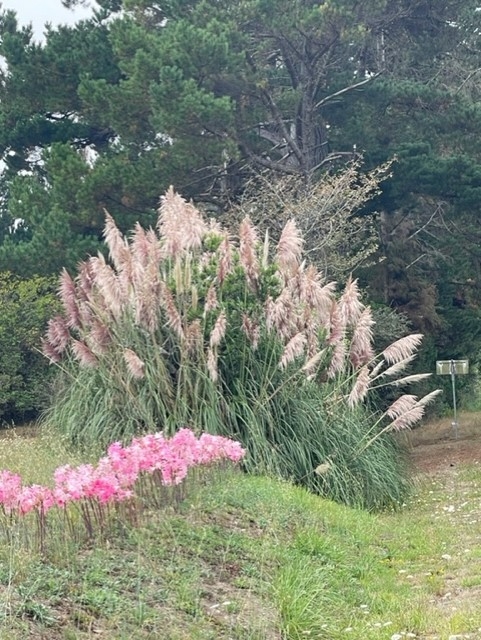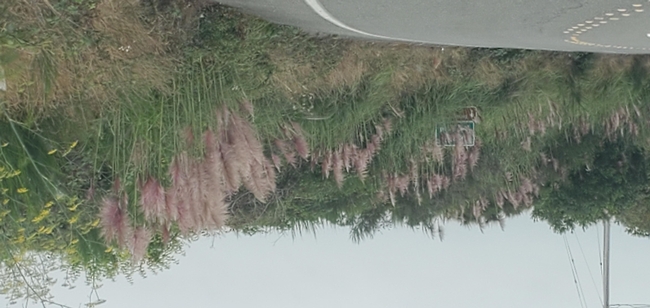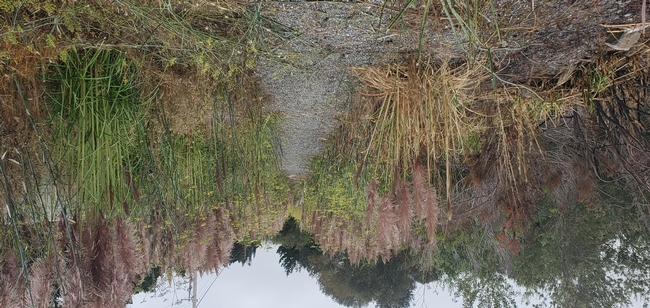
Drive anywhere along the coast this time of year and you will see huge stands of large 6'-10' tall grasses with dramatic pink plumes blowing in the wind like flags. What you are looking at is Jubata Grass or Pampas grass and it has become a real problem in our coastal habitat.
In fact, this well adapted plant will come up just about any place where there is little competition and will quickly establish on bare soil. It forms massive clumps along roadsides, steep cliffs, riverbanks, and open areas that have been disturbed by human activities or natural disturbances. You will notice it in town around parking lots and in that bare spot of dirt near the sidewalk or the edge of the garden. With the ability to grow in many conditions Jubata grass can quickly spread and become out of control.
Introduced to California in 1848 by nursery operators, Pampas Grass (Cortaderia selloana) became a popular specimen plant with fluffy white plumes used for decorating. It is not the species causing all the problems. Several decades ago another species, Cortaderia jubata, was introduced and has since become a primary invasive weed in coastal areas of the West. It is generally distinguished by a pinkish flower plume, but otherwise difficult to tell apart from C. selloana. Because it spreads quickly and is miserably impenetrable, it was once used by logging companies to keep deer from eating reforested areas. In the 1960's, Georgia Pacific had to abandon 1,100 acres in Humboldt County where jubata grass had taken over as there was no economical way to control it. At that time 7,000 additional acres were severely infested. Now recognized as incredibly invasive, lawmakers, educators, nurseries, restoration groups and homeowners are uniting in the fight to eradicate the pest.
Dramatic and majestic, Jubata Grass can be hard to dislike. Attractive feathery pinkish plumes appear on top of tall stalks well above a fountain of graceful leaves from July through September. However, we need to educate ourselves and others about the downside of this dramatic invasive plant. Just think… each plant can produce millions of seeds annually that can travel several miles. Once established, the vigorously growing jubata grass pushes out other vegetation and animals already living there. It takes over, clogging waterways and wetlands and causing environmental chaos. When dry, it can be a serious fire hazard. The sharply serrated leaf blades can cause physical harm to animals and humans. They are highly undesirable as food or shelter to birds and other wildlife.
So, how do we control it? We can begin by becoming aware of the problem. Next, we can work to remove any plants that we can. And, we can reduce the “seed bank” by removing flower plumes. In a recent hour spent along the roadside, I bagged over 150 seed plumes, each containing thousands of seed that will not have a change to germinate. Small plants can be pulled quite easily, so carry a pair of work gloves on your next hike.
Plume/Seed head removal: If removing the whole plant seems daunting, consider removing the flower stalks as they emerge to prevent seed dispersal. This will need to be done early and repeatedly throughout the blooming season. Although the flower plumes are striking, DO NOT pick them for decorations or floral arrangements.The flowing flag of the seed head should be cut and burned to prevent seed dispersal. Alternatively, cut and bag all seed heads as soon as they appear and send the bag to the landfill. Avoid leaving them on the ground or composting them.

Research has shown that burning and grazing do not provide long term control and pampas plants quickly resprout. Biological controls have not been investigated. Glyphosate is the most effective herbicide to reach the deep roots of Jubata and Pampas Grass. Follow manufactures instructions carefully. Protect nearby desirable plants from herbicide spray drift and apply when insects are not active. Do not overspray and avoid runoff into waterways. Please see link below for more information regarding Glyphosate.
Resources:
UC IPM Glyphosate Link
University of California Weed Research and Information Center Leaflet 99-1 Link
California Invasive Plant Council Report Link
California Invasive Plant Council Cortaderia jubata plant profile Link
Pacific Horticulture Article by John Madison - Pampas Grasses: One a Weed and One a Garden Queen Link
Images - permissions granted
Pampas Grass in Landscape - photo by Sherida Phibbs, UCCE Master Gardener Coordinator
Coastal hillsides covered in invasive Jubata grass - photo by Annie Sciotte, UCCE Master Gardener
Making this trail unusable - photo by Annie Sciotte, UCCE Master Gardener


